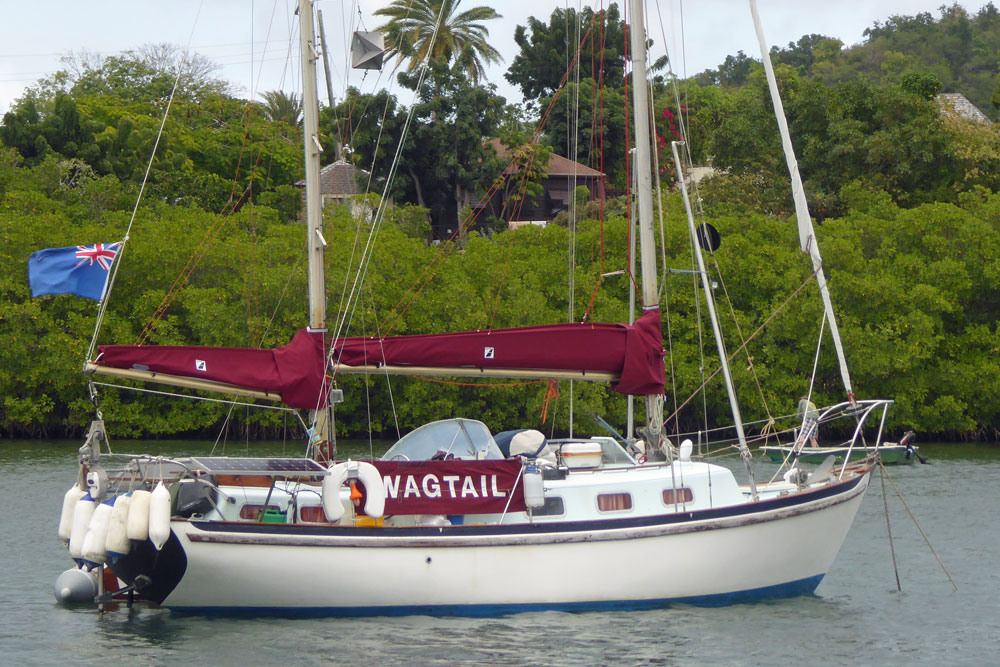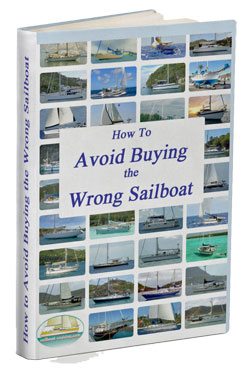- Home
- Cruising Yachts 30' to 35'
- Seadog 30
The Seadog 30 Sailboat
The Seadog 30, a heavy displacement ketch, was designed by Reg Freeman and built in UK by Reg Freeman Yachts Ltd.
Published Specification for the Seadog 30
Underwater Profile: Triple keel
Hull Material: GRP
Length Overall: 30'0" / 9.14m
Waterline Length: 24'0" / 7.32m
Beam: 9'6" / 2.9m
Draft: 3'6"/ 1.1m
Rig Type: Ketch
Displacement: 12,880lb / 5,842kg
Designer: Reg Freeman
Builder: Reg Freeman Yachts (UK)
Year First Built: 1966
Year Last Built: 1974
Number Built: 130
Owners Association: SeaDog Owners Association
Published Design Ratios for the Seadog 30
1. Sail Area/Displacement Ratio: 14.9
2. Ballast/Displacement Ratio: 30.4
3. Displacement/Length Ratio: 416
4. Comfort Ratio: 38.5
5. Capsize Screening Formula: 1.6
read more about these all-revealing numbers...
Summary Analysis of the Design Ratios for the Seadog 30
1. A Sail Area/Displacement Ratio of just 14.9 suggests that the Seadog 30 will need a stiff breeze to get her going. In light conditions, unless you've got plenty of time on your hands, motor-sailing may be the way to go.
2. A Ballast/Displacement Ratio of 30.4 means that unless the bulk of the ballast is concentrated in a bulb at the foot of her keel, the Seadog 30 will have a tendency to heel excessively in a gust, and she'll need to be reefed early to keep her sailing upright in a moderate breeze.
3. A Displacement/Length Ratio of 416, tells us the Seadog 30 is firmly in the ultra-heavy displacement category. Load her up as much as you like and her performance will be hardly affected, not that it was ever startling. Few if any sailboats are built to this displacement category these days - but they remain popular with some long-distance sailors.
4. Ted Brewer's Comfort Ratio of 38.5 suggests that crew comfort of a Seadog 30 in a seaway is similar to what you would associate with the motion of a moderate bluewater cruising boat - a predictable and acceptable motion for most seasoned sailors.
5. The Capsize Screening Formula (CSF) of 1.6 tells us that a Seadog 30 would be a safer choice of sailboat for an ocean passage than one with a CSF of more than 2.0.
Cruisers' Questions about this Sailboat...
What are the main features of the Seadog 30 ketch?
What are the main features of the Seadog 30 ketch?
The Seadog 30 ketch is a small centre cockpit cruiser with a long shallow keel and twin bilge keels. It has a ketch rig with a custom-fitted extended bowsprit for better sail balance. It has a separate aft cabin with two berths and a heads compartment, and a forward cabin with a V-berth and another heads compartment. It also has a spacious saloon with a galley and a dinette that can convert to a double berth. The Seadog 30 ketch is known for its robust construction, seaworthy performance, and charming character.
How many Seadog 30 ketches were built and when?
How many Seadog 30 ketches were built and when?
The Seadog 30 ketch was first introduced in 1964 by Reg Freeman Yachts Ltd in Essex, England. The design was based on the earlier Seadog 27, which was also designed by Reg Freeman. The production of the Seadog 30 ketch continued until 1975, with some variations in the hull shape and interior layout over the years. It is estimated that about 270 Seadog 30 ketches were built in total, of which only about 27 were the full keel Deep Sea Dogs, the last ones built.
How much does a Seadog 30 ketch cost and where can I find one for sale?
How much does a Seadog 30 ketch cost and where can I find one for sale?
The price of a Seadog 30 ketch depends on its condition, age, equipment, and location. Based on the web search results, the average asking price for a Seadog 30 ketch in July 2023 was around £20,000. However, some examples were listed for as low as £14,000 or as high as £25,000.
Who was Reg Freeman?
Who was Reg Freeman?
Reg Freeman was a British naval architect who designed various types of boats, including the Seadog 30 ketch. He was born in 1910 and started his career as a draughtsman for the Royal Navy. He later worked for several yacht builders and brokers, such as Camper and Nicholsons, Moody's, and Hillyards. He also designed some of the early Hallberg-Rassy yachts, such as the Rasmus 35 and the Monsun 31.
He was known for his innovative and versatile designs, which ranged from motorboats to sailing yachts, and from small cruisers to large ocean racers. He also had a keen interest in traditional wooden boats and classic yachts, and wrote several books and articles on the subject. He was a founding member of the Old Gaffers Association and a long-time supporter of the National Maritime Museum.
He died in 1999 at the age of 89, leaving behind a legacy of over 300 boat designs and a wealth of maritime knowledge. He is remembered as one of the most influential and prolific British yacht designers of the 20th century.
The above answers were drafted by sailboat-cruising.com using GPT-4 (OpenAI’s large-scale language-generation model) as a research assistant to develop source material; to the best of our knowledge, we believe them to be accurate.
Recent Articles
-
Is An SSB Marine Radio Installation Worth Having on Your Sailboat?
Apr 14, 25 02:31 PM
SSB marine radio is expensive to buy and install, but remains the bluewater sailors' favourite means of long-range communication, and here's why -
Correct VHF Radio Procedure: Your Questions Answered
Apr 14, 25 08:37 AM
Got a question about correct VHF radio procedure? Odds are you'll find your answer here... -
VHF Marine Radio; Which One is Right for Your Boat?
Apr 14, 25 05:09 AM
If you're looking to buy a VHF Marine Radio the choice can be a bit overwhelming. So what should it be, a fixed VHF or a handheld VHF? Maybe one with AIS or GPS built in perhaps?














